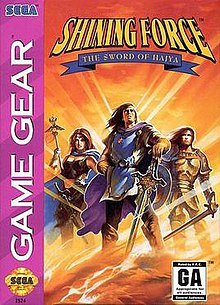Ninja Gaiden is a media franchise based on action video games by Tecmo featuring the ninja Ryu Hayabusa as its protagonist. The series was originally known as Ninja Ryukenden in Japan. The word "gaiden" in the North American Ninja Gaiden title means "side story" in Japanese. The original arcade version, first two Nintendo Entertainment System games and Game Boy game were released as Shadow Warriors in PAL regions. As of 2008, the series has shipped over 7.7 million copies.
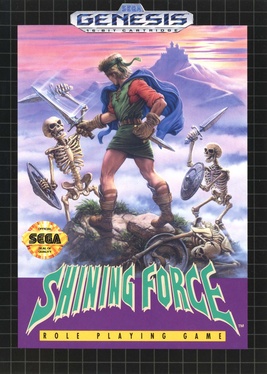
Shining Force is a 1992 turn-based tactical role-playing game for the Sega Genesis console. It is the second entry of the Shining series of video games, following Shining in the Darkness. While primarily a traditional fantasy-themed game, it contains some science fiction elements.
The Shining series is a name of role-playing video games published by Sega, who owns the property. The first game, Shining in the Darkness, was a first-person dungeon crawler with randomly encountered, turn-based battles. The next game released in the series was Shining Force, which was a turn-based strategy style tactical role-playing game with battle scenes acted out with sprites. Other directions include Shining Soul, a dungeon crawl action role-playing game with roguelike elements, and a number of traditional Japanese role-playing games. Shining Resonance Refrain was released on PlayStation 4, Xbox One, Steam PC and Nintendo Switch worldwide across 2018.

Shining in the Darkness, released as Shining and the Darkness in Japan, is a 1991 role-playing video game for the Mega Drive/Genesis video game console. It was the first in the Shining series.

Ninja Gaiden II: The Dark Sword of Chaos, known in Europe as Shadow Warriors II: The Dark Sword of Chaos, is a 1990 action-platform game developed and published by Tecmo for the Nintendo Entertainment System. It is the second installment in the Ninja Gaiden trilogy for the NES and was released in North America and Japan in 1990, and in Europe in 1992. An arcade video game version was also introduced by Nintendo for their PlayChoice-10 system in 1990.

Shining Force II is a tactical role-playing game for the Mega Drive/Genesis console developed by Sonic! Software Planning and published by Sega in 1993. Its storyline is not directly connected to the original Shining Force, although a Game Gear title Shining Force Gaiden: Final Conflict links the two games' plots.

Spider-Man vs. The Kingpin is a video game produced by Sega and developed by Technopop initially on the Mega Drive/Genesis. It was ported internally by Sega for the Master System and Game Gear consoles, the latter being published by Acclaim Entertainment through its Flying Edge division. An updated version released for the Sega CD was also done internally at Sega under the name of The Amazing Spider-Man vs. The Kingpin.

Shining Force III is a tactical role-playing game released for the Sega Saturn. In Japan, Shining Force III was an episodic video game with three discs - Scenario 1, Scenario 2, and Scenario 3 - released individually across late 1997 and 1998. Game data could be saved and transferred forward to later scenarios in order to influence events and obtain rewards in-game, a mechanic marketed as the "Synchronicity system". Each scenario utilizes the same core gameplay mechanics, but follows a different character's perspective of the overarching narrative in a shared game world. In North America and Europe, only the first entry, Scenario 1, was translated into English, and was simply titled Shining Force III for its release in mid-1998.
Phantasy Star is a series of console role-playing video games and other supplementary media created by Sega. The series debuted in 1987 on the Master System with Phantasy Star, and continues into the present with Phantasy Star Online 2 and other extensions of the Phantasy Star Online sub-series. Each of the games in the series features a science fantasy setting featuring a cross-genre combination of magic and technology.

Lunar: Eternal Blue is a role-playing video game developed by Game Arts in association with Studio Alex for the Sega CD as the sequel to Lunar: The Silver Star. The game was originally released in December 1994 in Japan, and later in North America in September 1995 by Working Designs. Eternal Blue expanded the story and gameplay of its predecessor, and made more use of the Sega CD's hardware, including more detailed graphics, longer, more elaborate animated cutscenes, and more extensive use of voice acting. Critics were mostly pleased with the title, giving particular merit to the game's English translation and further expansion of the role-playing game genre in CD format.
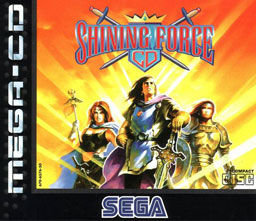
Shining Force CD (シャイニングフォースCD) is a 1994 strategy role-playing game developed by Sonic! Software Planning for the Sega CD, and a remake of the games Shining Force Gaiden and Shining Force Gaiden II that were originally for the Game Gear. Although the game went largely unnoticed upon release in 1995, it has gained a cult following and is considered to be one of the best titles released for the Sega CD platform.
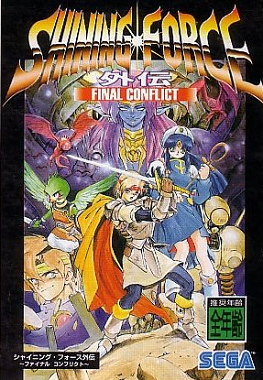
Shining Force Gaiden: Final Conflict is a 1995 tactical role-playing game for the Game Gear, taking place between the games Shining Force and Shining Force II. It was released after both games, with the intention of connecting their plots. Despite its name, it is not directly story-related to Shining Force Gaiden or Shining Force Gaiden II, also released for Game Gear. Unlike most of its predecessors, the game was never released outside Japan. English patches have been created by fans for players who cannot read Japanese.
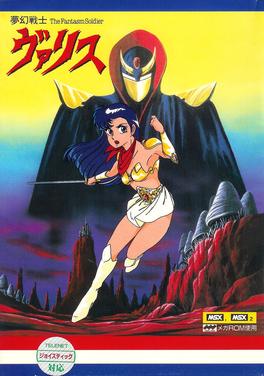
Valis: The Fantasm Soldier is a 1986 action-platform video game originally developed by Wolf Team and published by Telenet Japan for the MSX, PC-8801, X1, FM-7, and PC-9801 home computers. It is the first entry in the Valis series. It stars Yuko Asou, a Japanese teenage schoolgirl chosen as the Valis warrior and wielder of the mystical Valis sword to protect the Earth, the land of spirits, and the dream world Vecanti from demon lord Rogles. Throughout the journey, the player explores and search for items and power-ups, while fighting enemies and defeating bosses to increase Yuko's attributes.
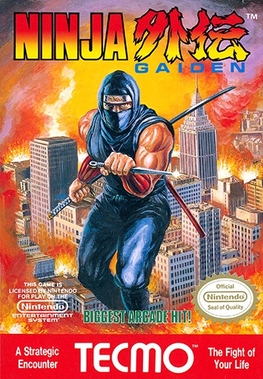
Ninja Gaiden, released in Japan as Ninja Ryūkenden and as Shadow Warriors in Europe, is a 1988 action-platform game developed and published by Tecmo for the Nintendo Entertainment System. Its development and release coincided with the beat 'em up arcade version of the same name. It was released in December 1988 in Japan, in March 1989 in North America, and in August 1991 in Europe. It has been ported to several other platforms, including the PC Engine, the Super NES, and mobile phones.

Valis III is a 1990 action-platform video game originally developed by Laser Soft, published by Telenet Japan and NEC for the TurboGrafx-CD. A Sega Genesis version was released in 1991. It is the third entry in the Valis series. It stars Yuko Asou, a Japanese teenage schoolgirl chosen as the Valis warrior and wielder of the mystical Valis sword after the events of Valis II. King Glames, wielder of the sword Leethus, leads denizens of the dark world to conquer both Vecanti and Earth, seeking refuge for his people amid the destruction of their planet. Together with the demon warrior-maiden Cham and her sister Valna, Yuko must prevent Glames from destroying both worlds. Through the journey, the player explores and searches for items and power-ups while fighting enemies and defeating bosses.

Valis II is a 1989 action-platform video game originally developed by Laser Soft, published by Telenet Japan and NEC for the PC Engine CD-ROM²/TurboGrafx-CD. A home computer version was released for PC-8801, MSX2, PC-9801 and X68000. A super deformed-style remake was also released in 1992 for the Sega Mega Drive/Genesis. It is the second entry in the eponymous series. It stars Yuko Asou, a Japanese schoolgirl teenager chosen to become the Valis warrior by wielding the titular mystical sword, after defeating the demon lord Rogles. The dream world Vecanti fell under the rule of emperor Megas, whose hatred towards his brother Rogles and bloodthirsty tendencies seeks to wipe out traces of the former tyrant, including his supporters. Gameplay varies between each version but all share similar elements, as the player explores and search for items and power-ups, while fighting enemies and defeat bosses.
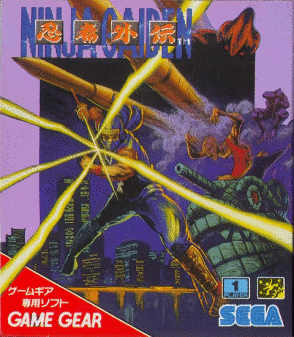
Ninja Gaiden (忍者外伝) is a 1991 action-platform game released for the Game Gear by Sega with license from Tecmo. It stars Ryu Hayabusa and is part of the Ninja Gaiden series, although it features a plot not connected to any of the other Ninja Gaiden games. The gameplay is similar to previous Ninja Gaiden games where the player jumps between platforms defeating and avoiding enemies.

Ninja Gaiden is a side-scrolling, hack & slash, platform-action video game developed by SIMS and released by Sega for the Master System in 1992, with license from Tecmo.

Shining Force Gaiden: Ensei – Jashin no Kuni he is a 1992 tactical role-playing game released only in Japan for the Game Gear. It takes place 20 years after the Shining Force, and is the first game in the Shining Force Gaiden series.
